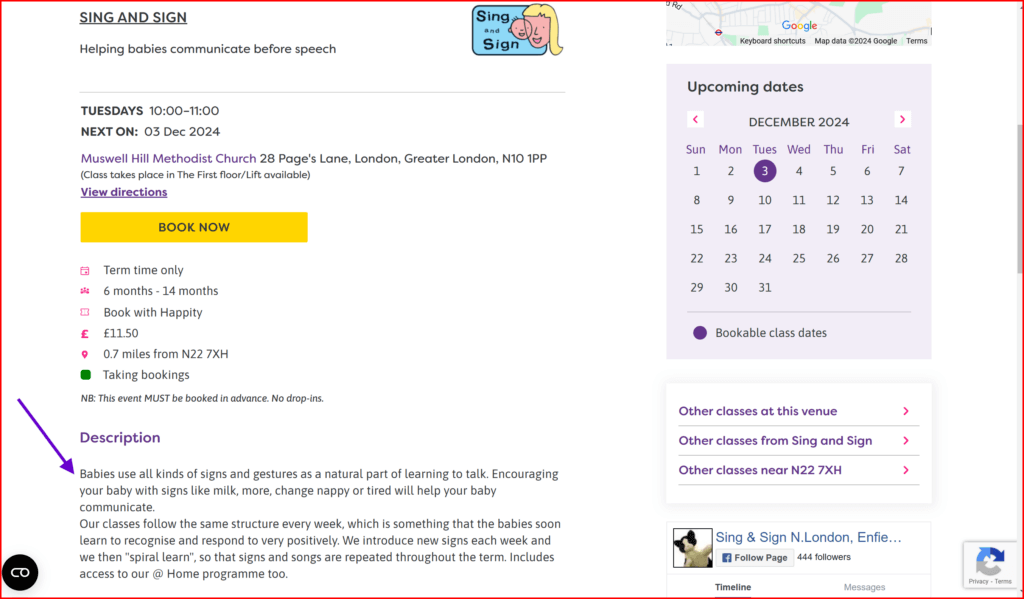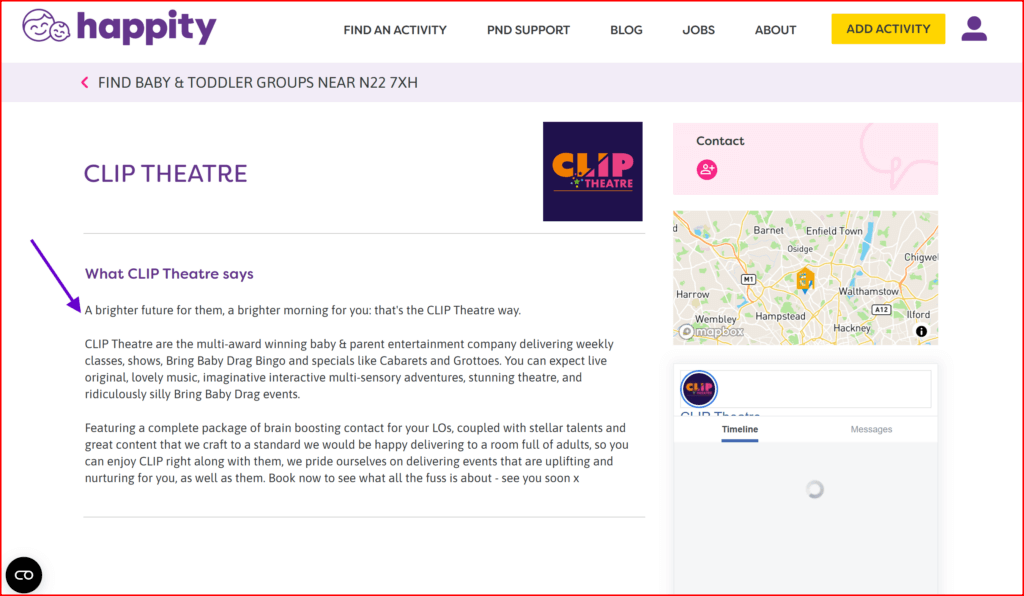How do you write a brilliant description for your classes – the kind that will tip your readers over from ‘that looks like fun’, to actually making a booking?
When it comes to copywriting, we’re often told that less is more. And while it’s true that no-one wants to wade through long paragraphs of description on your listings, you’ll want to balance this with making sure you’ve included all the info a parent might need to persuade them to come along.
Here are our 7 top tips for getting it right every time, and making your class descriptions irresistible.
1. Put Everything In The Right Place
On Happity you can enter two types of description for your class listing:
Short description: this sits at the top of your page, and is a short, snappy summary of 80 characters or less (see screenshot below)

Short Description on Happity
Long Description: This sits lower down the page – underneath your date, time, and booking link – and gives potential customers more information about your class, so they can decide if it’s right for them (see screenshot below).

Long Description on Happity
You’ll enter your Short Description and Long Description in Profile > Activities.
Don’t forget to also fill out the About You section in Profile > Organisation. This is where you can tell potential customers more about your business as a whole, across all the different classes that you run.
You can include your values, aims, and any themes which tie your classes together. See an example below.

About You on Happity
2. Tell Us What Is Going To Happen
Remember, new parents have never attended classes before. They might not have even known classes existed before they became parents! So they will likely have all sorts of questions circulating in their minds… Will I have to sing? Or dance? What happens if my baby falls asleep? Or starts crying? Do I have to make sure I’ve done a feed before the class begins?
Giving your customers a clear outline of what happens during your class can be very powerful in helping to put their minds at rest.
For example:
Every class starts with the ‘hello’ song, where we go around and welcome each child to the session individually. After that we sing our core songs, I pull from the same selection week-to-week throughout the term, as the little ones thrive on repetition (and please don’t worry if you don’t know the words)!
Then we play with the instruments and scarves, and finally the session ends with the parachute, bubbles and our goodbye song.
The class is a safe space where you are welcome to feed, change, get up and move around with your baby, or anything else which you need to do.
3. Name Check Those Developmental Skills

Did you know that 80% of parents say they attend classes to help their child’s development? That’s more than those who attend to ‘get out of the house’ (70%), to ‘socialise with other parents’ (64%), or even to ‘have fun’ (33%)!1
Developmental skills include:
- Gross Motor : e.g. crawling, walking, jumping
- Fine Motor: e.g. grabbing, holding, writing
- Speech & Language
- Cognitive & Intellectual e.g. recognising shapes and counting
- Social & Emotional e.g. turn taking, sharing, playing together
Be sure to mention any of these skills which are relevant to your class in the description. They are a powerful draw for parents.
1. Source: Happity’s Big Parent Survey, 2024
4. Keep Your Tone Friendly, And Be Inclusive
Don’t forget that your customers are buying into you as a person, as much as they are buying into the class – so try to get a bit of your personality onto the page. Use chatty, simple language, and avoid long sentences or anything that sounds really formal.
A note on keeping your classes inclusive: at Happity we do try to say ‘parent’ rather than ‘mum’. Even if the majority of your customers are mums right now, you’ll want to make sure dads and other caregivers don’t feel excluded.
And don’t forget to be super welcoming to grandparents – more than 50% of grandparents in the UK help out with childcare!2
2. Source: Grandparents are saving families £96bn a year in equivalent childcare costs – SunLife
5. Don’t Use ChatGPT
We know, we know, AI is everywhere at the moment. It can feel tempting to simply hand over your entire description to ChatGPT, or a similar tool.
But we do recommend that you avoid using AI to create your descriptions – at least for now. These tools have a long way to go before they can completely recreate your authentic tone and personality from a simple prompt. Unless you’re a Pro at working with ChatGPT, it’s going to be very obvious to the reader that your description was not written by a human, which can be off-putting.
6. Reassure Parents About The Venue

Remember those questions swirling around a new parent’s head in Section 2? While some of those are about what happens at the class, others are more related to the venue it takes place in.
While these might seem like small things, to a new parent feeling overwhelmed, re-assurance can make all the difference to actually getting out of the house.
Venue information might include:
- Are there baby-changing facilities?
- Is there a car park?
- Are there any stairs into the venue / your room?
- Where do parents park buggies/prams? (If outside, they will want to bring a rain cover / lock)
- Is there a cafe?
When you’re adding a class on Happity, you can add useful information about the venue in the Other section, which is the last screen.
Go to My classes > Weekly timetable and click Edit on one of your classes, then scroll along to Section 4, to add this information .
7. Don’t forget to proof read

When you’ve been writing and tweaking your description for a while, it can be easy to miss the more ‘obvious’ things – like spelling, grammar, and punctuation.
If you can, try to take quick break and then read over what you’ve written with fresh eyes, before you hit publish.
You can also use the amazing Grammarly to check your writing and suggest improvements to make it even stronger.
Class provider? Let us help.
With 2.6m parents using Happity, we are the UK’s most-loved platform for finding baby and toddler classes.
Whether you want help reaching more families, need a booking system, or are just getting started, we’re here to support your journey.





